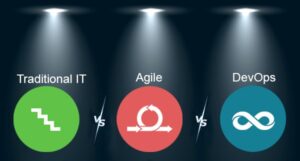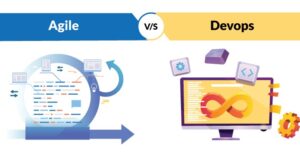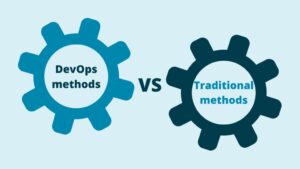Lets understand how DevOps vs. Agile vs. Traditional IT works!
DevOps vs Agile is a topic everyone is talking about.
When we consider the Software Delivery Life Cycle (SDLC), we frequently think of the most prevalent areas where content is created. Initially, software development did not fall under a single management umbrella. Software development may be described by the time it took to design or create an application.
In this blog, we will discuss the fundamental differences between conventional IT and Agile, as well as traditional IT against DevOps, to explain why DevOps has grown in popularity in recent years.

DevOps vs. Agile
Given their resemblance, Agile and DevOps aren’t the same, and some argue that DevOps is superior to Agile. It is critical to go down to the nuts and bolts to decrease complexity.
Comparison
- There is no disputing that both are software development approaches.
- Agile has been around for nearly 20 years, while DevOps as a service has only lately entered the scene.
- Agile and DevOps are concerned with rapid software development, and their philosophies are centred on how quickly software can be generated while causing no harm to the customer or business (Hemon et al., 2019).

Differences
The distinction between the two is what occurs following development.
- DevOps and agile both use software development, measurement, and deployment. However, true agility tends to stick around after these three phases. DevOps as a service, on the other hand, includes frequent operations. As a result, monitoring and software development is ongoing.
- Separate individuals are responsible for building, testing, and delivering software in an agile environment. Engineering specialists are responsible for everything in DevOps practices, including service development, operations development, and so on.
- Agile is more consistent with lean and decreasing waste, and ideas such as agile development finance and minimum viable product (MVP) are applicable.
- Instead of predicting measurements, Agile emphasizes and incorporates empiricism (adaptability, openness, and scrutiny).
| Important distinctions | |
| Agile | DevOps |
| · Customer feedback | · Individual responses |
| · The smaller sequence of releases | · Fast feedback and shorter release cycles |
| · Pay attention to the tempo | · Priority should be given to speed and automation |
| · Not ideal for marketing | · Ideal for business |
DevOps vs. Traditional IT
When conventional IT operations are compared to DevOps, it is evident how they vary and why the latter is increasingly being adopted by organizations globally. Some comparisons are shown below.

Time.
DevOps teams invest 33% greater time than traditional IT operations teams refining technology against failures. DevOps teams also devote less time to administrative assistance because of increased automation, self-service capabilities, and assistance scripts. With all of this extra time, DevOps as a service can devote 33% more time to infrastructure improvement and 15% more time to self-improvement through extra training and instruction.
Speed and data.
DevOps teams are often small, flexible, motivated by creativity, and focused on completing work quickly. One of the top five DevOps goals is agility. The data count for the feedback loop in traditional IT operations is limited to the service or application being worked on. It is impossible to remedy a downstream consequence that is not known or noticed. IT operations must pick up the pieces. That is why Cloud DevOps is more efficient in providing business apps, and the challenge for IT operations is to stay up with the speed of business.
Recuperation and crunch time
Being prepared for the risk of failure is a crucial DevOps as a service approach. Continuous testing, alarms, monitoring, and feedback loops are implemented to allow DevOps teams to respond rapidly and efficiently. Traditional IT operations teams demand twice as much time as DevOps teams. The crucial components for a speedy recovery are automated deployments and customizable infrastructure.
Software distribution
DevOps teams require around 36.6 minutes to deliver software, whereas conventional IT ops teams require approximately 85.1 minutes. This means that DevOps teams deliver apps at a rate that is more than twice as fast as traditional IT operations teams.
| Advantages of DevOps over Traditional IT |
| Ø Product failure is less likely. |
| Ø Flexibility and assistance have been improved. |
| Ø Reduced time to market. |
| Ø Increased team efficiency. |
| Ø Within the team, there is a clear product vision. |
Conclusion
Ultimately, the aims of Agile and DevOps are the same: to increase the pace and quality of software development, and discussing one without the other makes little sense. Traditional IT teams demand more time for each operation than the other two.
Many teams have found agile approaches to be quite beneficial, while others have struggled to reap the benefits of an agile approach. This might be due to a variety of factors, including teams not completely understanding or applying agile techniques appropriately. It is also possible that adding a Cloud DevOps strategy can assist firms who struggle with Agile to bridge the gaps and achieve the results they desired.






